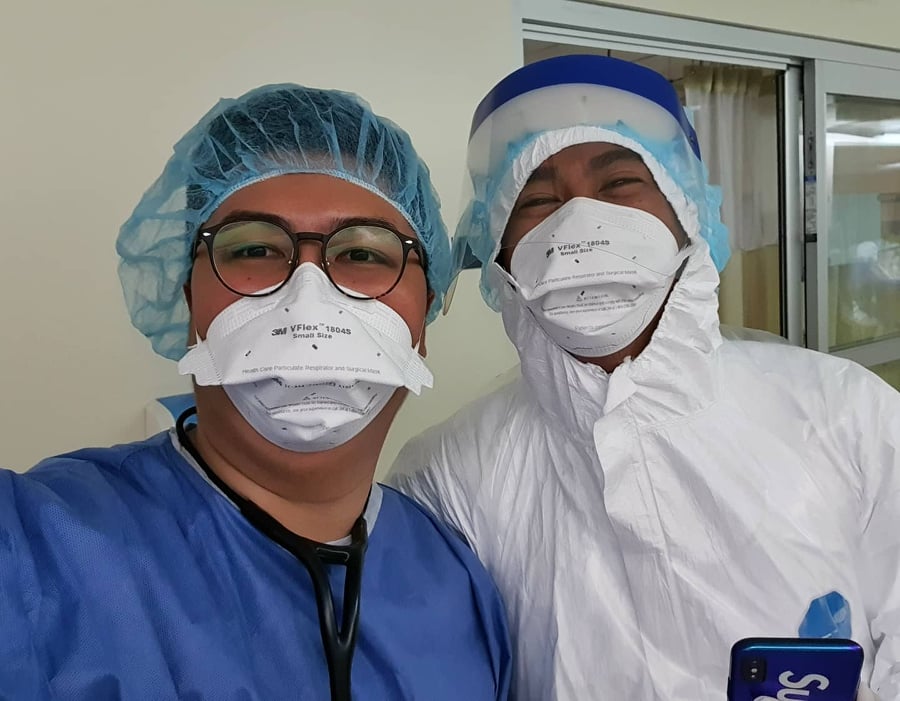By Jose Paolo S. dela Cruz
At this point, it’s no secret that very few tasks can prove to be quite as daunting – and as noble – as that of being a front liner in the battle against COVID-19. And many young doctors are most likely finding out now if their hearts and minds were, indeed, in the right place when they took their all-important oath.
Twenty-six year-old Christopher Bernard “CB” Javier, a medical resident at the Makati Medical Center’s emergency ward, finds himself at the forefront of this battle. In recent weeks, CB, who took up Medicine at the University of Sto. Tomas, has seen the ER he has been part of, transform in the time of COVID-19.

He recalls how the ER was relatively calm, at least as far as emergency wards are concerned, at the time President Rodrigo Duterte announced the Metro Manila-wide community quarantine on March 12, 2020. Such a moment, however, would prove to be nothing but the calm before the storm as ICU transfers, which normally ranged from one to two cases, rose to five to six in a span of 12 hours. The number of persons under investigation and monitoring (PUIs and PUMs) also began to rise.
Before he knew it, CB would be spending the majority of the next 21 days in the hospital, manning the fort in its increasingly busy ER section.
“It [the ER] has changed a lot especially during the first few days because a lot of doctors were quarantined – I think at one point around 30 doctors, residents and fellows included, were quarantined just in the Medicine department. So we all had to adjust. Medical residents and fellows were all pulled out from their respective rotations. We had to fill in floor duties, especially the isolation wards,” he says.

From four to six people, the number of ER doctors who manned the floor was pared down to three – with each one having to work 12-hour shifts, on a good day. For people upstairs, a six-day schedule that alternated 24-hour on-and-off schedules became the norm.
Makati Medical Center, which holds the lion’s share of successful treatments – reportedly consisting of 81 percent of all recovered cases in the Philippines, at some point – also wasted no time in converting certain areas into isolation-capable rooms.

The realities of being a front liner
The situation might have changed but the objective stays the same – to help the patients.
For CB, the most difficult aspect of being a medical front liner lies in the danger of contracting the disease. “The most basic thing that we could do is proper hand hygiene, I could not stress that enough,” he says, adding that he and his colleagues have been fortunate to have been provided with adequate protective equipment especially in the ER and isolation wards and ICUs.
He also shares the he and other front liners in the hospital even wrap their phones in plastic before going inside special areas. They also never forget to disinfect them after. “We also get our daily dose of Vitamin C to help strengthen our immune system,” he says.
The danger of contracting the disease also extends well beyond the front liner. As such, a second sacrifice is necessary. “We limit exposure, which means we have to distance ourselves from our families, relatives and friends,” he says.
In CB’s case, that would mean not being able to visit his one-year old daughter Emilia, who is currently living in another city with his partner. He last saw them on the first week of March.
As the number of COVID-19-related cases continue to rise, and the front liners slowly find themselves facing greater challenges, CB notes one positive thing that he has observed in the ER. “It helps that we are Filipinos and that in our core, we have a friendly and caring culture,” he says.
Despite the pressure, CB says that it’s not rare to see people still lightly bantering underneath their masks. Other front liners, such as guard and janitors, as well as relatives of patients, would always remember to ask him if he had eaten his lunch, or politely gesture to share theirs. “In times like these, being Filipino makes a difference,” he says.

At the time of this interview, CB, after 21 days of straight work at the Makati Medical Center, has finally earned a brief respite away from the ER. And while it would be romantic to think that father and daughter were immediately reunited at the end of it all, the good doctor would have to go straight to another home for some self-isolation, as a matter of precaution.
Still, there are no regrets for this young doctor. “This is the time when we’re needed the most. What we’re facing is bigger than ourselves, our education, work beyond what is asked for,” he says.
And while most of our front liners take their jobs to heart, CB says that they, too find themselves missing their friends and families every once in a while. “If you do have loved ones on the frontlines, do check up on them. It goes a long way for them, for all of us,” he reminds.





